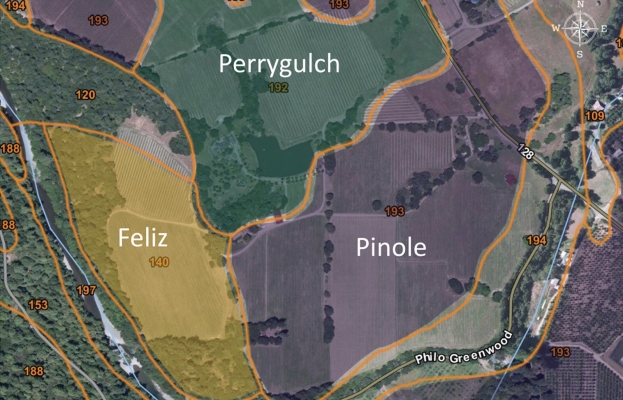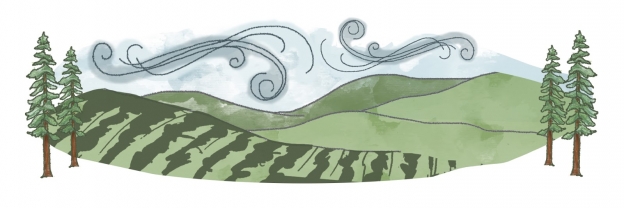Anderson Valley Soil Makes The Difference
We grow the fruit for Long Meadow Ranch Pinot Noirs and Chardonnays among the rolling, mineral-rich slopes of Mendocino County’s Anderson Valley. Nestled against the banks of the Navarro River and dense groves of Coast Redwoods, our vineyards benefit from some of California’s best conditions for Burgundian grape varieties. But perhaps our favorite aspect of our vineyards is the diversity in soil types, and the opportunity it has presented to showcase many different faces of these wines we love.

Winemaker Stéphane Vivier has spent years deeply exploring what makes each vineyard block unique and has created a series of wines that express each one’s distinct character, or its terroir. We informally refer to these wines as our “Soil Series” wines: our Feliz Chardonnay and our Pinole and Perrygulch Pinot Noirs. Each one tells its own story of place through sight, smell and taste.
TERROIR
There are no predestined vineyards so wine producers must work with what they are given, which is loosely described as a site’s Terroir (pronounced “Ter-wahr”). We like to think of terroir as the intersection of climate, soil, terrain and tradition. While a vineyard’s terroir is highly influenced by where the grapes are planted, the vineyard’s microclimate is also impacted by our human interaction with it. Examples of winegrowing traditions that influence terroir include soil health, cover crop diversity and maintenance, vine management (pruning, thinning), and irrigation choices.
CLIMATE + TERRAIN

Our Anderson Valley vineyards enjoy warm summers with a gentle marine influence. Narrow and low-lying, the valley funnels ocean fog and breezes in from the Pacific coast and rainfall here is plentiful, making it a cool, wet viticultural area. There is a large diurnal shift in temperatures in the deep end of the Anderson Valley, with up to 40-50°F differences from night to day. Our vineyards, surrounded by old-growth redwood trees, are mostly east-facing with an elevation variation of 50-120 feet and 2-35% slopes.
SOIL TYPES + WINE ATTRIBUTES
Within our 70 acres of vineyards there are three distinct soil types (or “loams”), Pinole, Perrygulch and Feliz. Each loam has nuanced differences and makes a big impact on favorable characteristics in our finished wines.

In the part of the vineyard where Feliz loam is most prevalent, flanked on one side by the Navarro River, lives our Chardonnay. Here you’ll find Dijon/Burgundy clones 76, 95 & 96 which typically yield less fruit that is bolder in flavor. Feliz is a fine loam that is well-draining and the darkest in color of the three dominant soil types. Chardonnay grown in Feliz loam tends to express a fresh vibrancy in the glass as well as a minerality that we love in our white wines. Our Anderson Valley Chardonnay’s long finish and ageability can also be attributed to its soil type.

The vineyard areas dominated by Pinole and Perrygulch loam are planted to Pinot Noir. Our Pinole block has slopes that vary between 2-15%. Pinole loam is very fine, with a lot of well-draining sand and clay in which Pinot Noir vines flourish. This block is planted to Calera, 777 and 828 clones, favored for their concentrated flavors, intensity, and depth. Wine made from this loam tends to have elegance and finesse, is low in alcohol and high in acidity – making it a great candidate for aging.
Perrygulch loam is the most dramatically sloped region of our Anderson Valley vineyards varying from 20-35%. The clay volumes are the highest here, while the pH is the lowest. “Big vines” tend to struggle here but the vigor is higher which tends to produce a higher concentration of flavors in the finished wines. The clones used in our Perrygulch block are 115, 667 and 777. Each clone lends its unique flavor, texture and aromatics to the finished wine. Pinot Noir grown in the Perrygulch loam tends to produce powerful, concentrated and structured wines that will age with grace for many years.
As you enjoy our Anderson Valley “Soil Series” wines we encourage you to think about the qualities that can be attributed to the particular loam they were grown in, as well as the complete picture you now have of this vineyard’s terroir.
